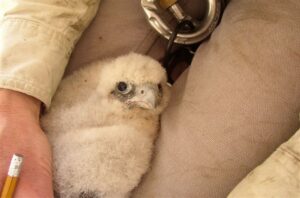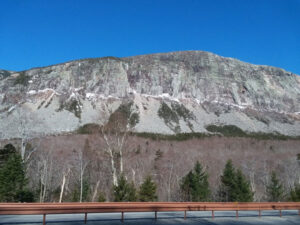(by Paul Nickerson)
The Peregrine Falcon was extirpated from the eastern United States in the early 1950s. The primary cause of its demise was the pesticide DDT and metabolites ingested in contaminated prey, resulting in thin-shelled eggs and occasionally in direct mortality. The Peregrine was one of the earlier Endangered Species Act listings.

Concern over the loss of these magnificent raptors resulted in several strategy meetings/conferences, largely among falconers, to discuss the possibility of restoring the birds to their historic range. The banning of DDT by the U.S Environmental Protection Agency in 1972 set the stage for recovery. The Peregrine Fund, founded and led by Dr. Tom Cade at Cornell University began successfully breeding Peregrines in captivity with the idea of releasing them to the wild.
The U.S. Fish and Wildlife Service (USFWS) became more involved in the recovery effort through funding, permitting, and coordination with the states. Historic nest site, known as aeries, were inventoried with the idea of choosing release or “hack” sites where young birds could be placed and returned to the wild. Owls were a threat initially, so release sites in the White Mountains enabled us to get higher than where the owls hunted.
After several years of successful releases, a pair of the released birds nested in Franconia Notch in 1981 and raised two young. This was the first successful nesting at an historic aerie in nearly 30 years. Gradually falcons began to reoccupy sites in both the White Mountains and the Green Mountains, and that resulted in the adventure I’ll relate next!

As the recovery effort unfolded, several pairs nested in the White Mountains. In 1987, one pair nested on Cannon Mountain, across the valley from Eagle Cliff. This pair was watched closely by observers who determined that the incubation period was extending well beyond normal. Rather than lose the nest’s productivity to abandonment, cooperators decided to take the non-viable eggs and replace them with live young. That meant a team would need to climb to the aerie to place the foster young in the nest. This was done in two separate trips.
I was part of a group that went up in mid-June. There were four of us altogether: Jim Weaver and Beth Dickervitz from the Peregrine Fund, and Ron Joseph and I from the USFWS. Beth carried a chick in a protective pouch thatwould be placed in the nest when we reached the top. We decided to climb up the face of Cannon Mountain and when we got halfway up, Beth got grit under one of her contact lenses and paused to pour water on it. At the time we were standing on a very narrow ledge and I was getting very nervous as we were several hundred feet up the cliff. Finally, we continued to climb and came to a spot without obvious passage to the top. Jim, an experienced climber, explored possible routes and found a narrow gap that we could get through. Long story short, we did make it and the young Peregrine was successfully fostered. The adult falcons were less than pleased with our presence, and they flew around us screaming. That was inspiring to all of us.
I was not thrilled about the prospect of climbing back down the face of the mountain, but my worries were needless. Turns out there was a trail that led to the bottom, so our descent was uneventful. During my 28+ years working with endangered species, I have had some fascinating experiences but none as thrilling as climbing the face of New Hampshire’s Cannon Mountain.
Prior to joining NH Audubon’s Board of Trustees, Paul Nickerson had a long career with the Northeast Region of the US Fish and Wildlife Service, including serving as the leader of Endangered Species recovery planning for the Northeast Region.
*This article is part of a monthly series celebrating the 50th Anniversary of the Endangered Species Act.
